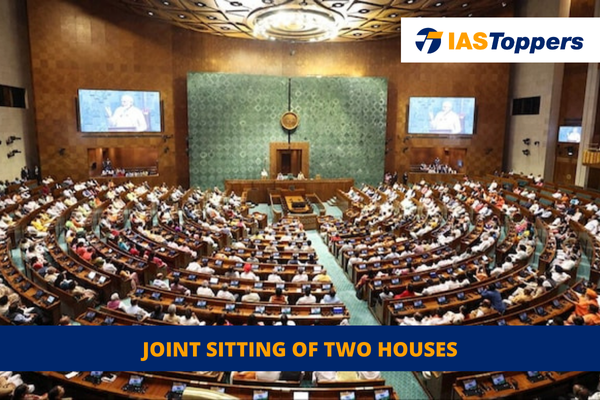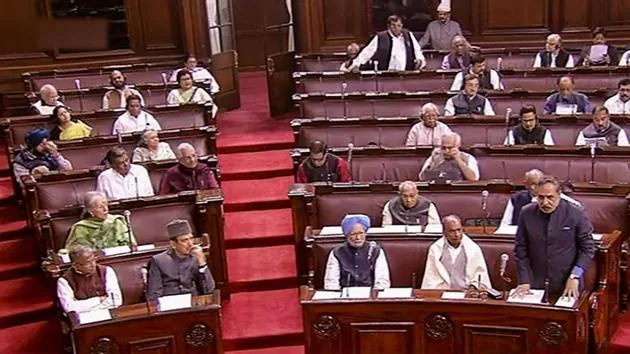Joint sitting of the parliament aims to overcome potential deadlocks between the Rajya Sabha and the Lok Sabha. In the Indian Parliament, which follows a bicameral system, the concurrence of both houses is necessary to pass any legislation and hence necessitating the requirement of Joint sitting. The President of India calls for such sessions. The Central Hall is currently utilized for these joint sittings, which also serves as the venue for the President’s address at the beginning of each new parliamentary session after general elections.
Joint Sitting of the Parliament (Article 108) will be helpful for UPSC IAS Exam preparation. GS Paper-2 Indian Polity.
Table of Content
- Joint Sitting of the Parliament
- Summoning of Joint Sitting of the Parliament
- Presiding Officer
- Quorum and Rules
- Passing of Bills
- Historical Usage
- Conclusion
- Frequently Asked Questions (FAQs)
Joint Sitting of the Parliament
- The Parliament of India is bicameral. Concurrence of both houses is required to pass any bill.
- However, to address potential deadlocks between the Rajya Sabha and the Lok Sabha, the framers of the Constitution of India incorporated provisions for joint sittings.
- Article 108 of the Constitution of India empowers the summoning of a joint sitting of Parliament in three circumstances:
- Rejection of the bill by the receiving House.
- Final disagreement between the Houses regarding the bill’s amendments.
- Elapse of more than six months without the receiving House passing the bill.
Summoning of Joint Sitting of the Parliament
- To address the deadlock, the President has the authority to summon a joint sitting of both Houses for deliberation and voting on the bill.
- It is important to note that joint sittings apply only to ordinary bills or financial bills.
- They are not applicable to Money bills or Constitutional amendment bills.
- Money bills grant overriding powers to the Lok Sabha, while Constitutional amendment bills require separate passage in each House.
Calculation of Time:
- The six-month period does not include the duration of prorogation or adjournment of the receiving House for more than four consecutive days.
Effect of Dissolution:
- If the bill has already lapsed due to the dissolution of the Lok Sabha, a joint sitting cannot be summoned.
- However, if the Lok Sabha dissolves after the President’s notification of intent to summon a joint sitting, the joint sitting can proceed as the bill does not lapse in this scenario.
- Once the President notifies the intention to hold a joint sitting, neither House can take further action on the bill.
Presiding Officer
- The Speaker of Lok Sabha presides over the joint sitting, or in their absence, the Deputy Speaker.
- If both are absent, the Deputy Chairman of Rajya Sabha assumes the role.
- If the Deputy Chairman is also absent, the members present at the joint sitting determine an alternate presiding officer.
- Note: The Chairman of Rajya Sabha does not preside over joint sittings since they are not a member of either House.
Quorum and Rules
- A joint sitting requires a quorum of one-tenth of the total number of members from both Houses.
- The joint sitting is governed by the Rules of Procedure of Lok Sabha, not Rajya Sabha.
Passing of Bills
- If the bill in dispute receives majority approval from the members present and voting at the joint sitting, it is deemed passed by both Houses.
- Usually, the Lok Sabha, with a greater number of members, holds an advantage in a joint sitting.
Amendments:
- The Constitution restricts the proposal of new amendments during a joint sitting, except in two cases:
- Amendments causing final disagreement between the Houses.
- Amendments necessitated by the delay in bill passage.
Historical Usage
- Since 1950, joint sittings have been invoked only three times.
- Notable bills passed during joint sittings include:
- Dowry Prohibition Bill, 1960
- Banking Service Commission (Repeal) Bill, 1977
- Prevention of Terrorism Bill, 2002.
Conclusion
The joint sitting of the Indian Parliament has faced criticism due to the dominance of the Lok Sabha, leading to the lower house’s decisions prevailing regardless of the Rajya Sabha’s voice. This becomes significant when the ruling party has a minority in the Rajya Sabha but seeks to pass bills through joint sittings. However, the Constitution’s provision for joint sessions reflects the foresight of the Constitution’s authors in addressing potential deadlocks between the two houses. Additionally, it underscores the importance of the Rajya Sabha as a check on hasty legislation by the government. Despite this, joint sittings have been summoned only on three occasions since 1950, highlighting their infrequent utilization.
Ref: Source-1
FAQs(Frequently Asked Questions)
Who presides over the joint sitting of the parliament?
The Speaker or in their absence Deputy Speaker of Lok Sabha presides over the joint sitting of the parliament.
The Chairman of the Rajya Sabha or Vice President does not preside over joint sittings.
How many times joint sittings are held in India?
Joint sitting of parliament is held only 3 times in India till now. The first joint sitting was held on the Dowry Prohibition Bill 1960, the second joint sitting was held on the Banking Service Commission (Repeal) Bill 1977 and the last joint sitting was held on the Prevention of Terrorism Bill, 2002.
Joint sitting of parliament taken from which country?
It is taken from the Australian Constitution.
Is there any provision for joint sitting in State Legislature?
No, there is no provision for joint sitting in the state legislature.



